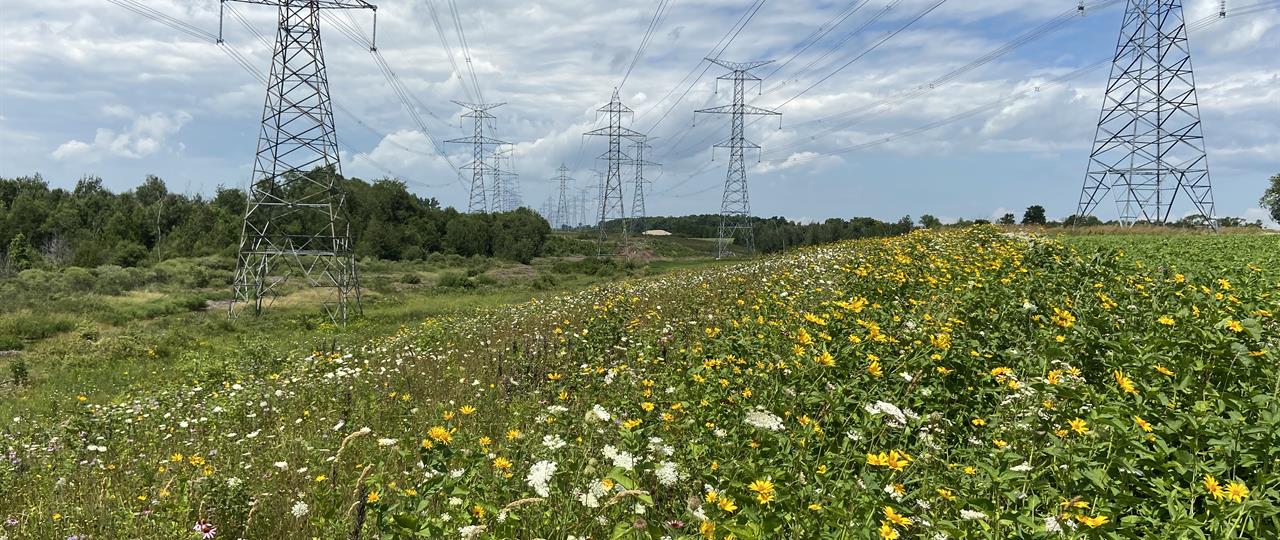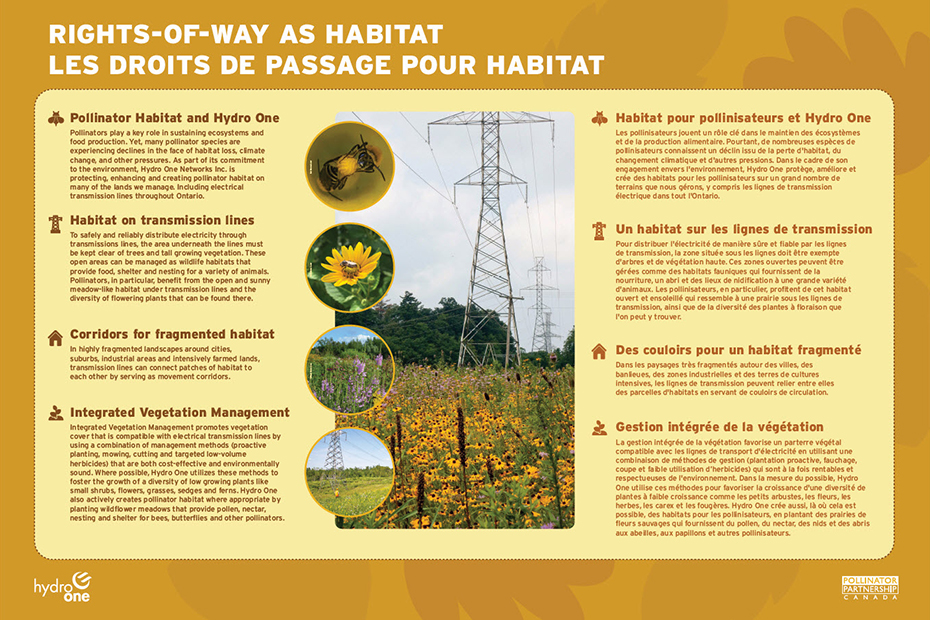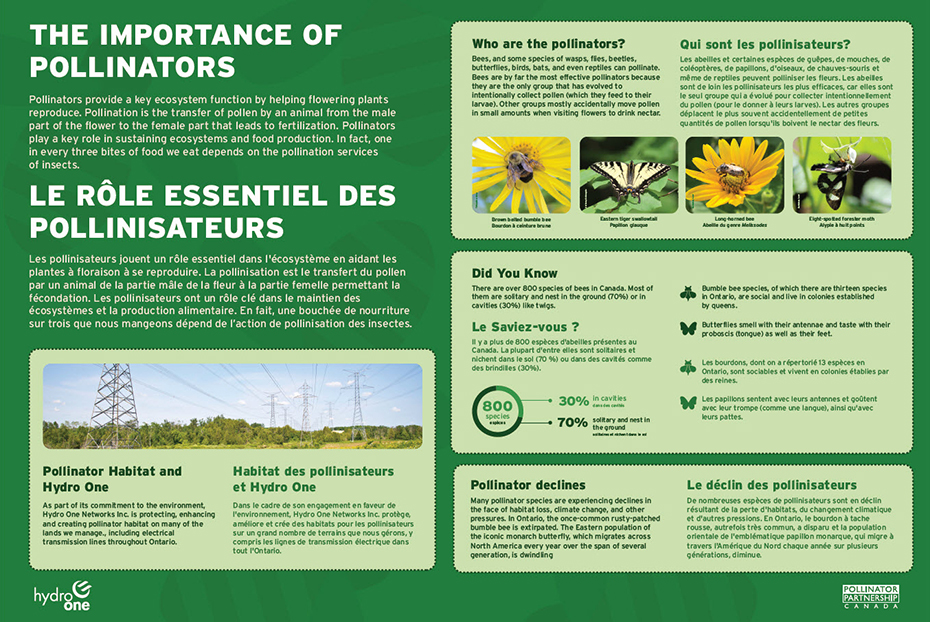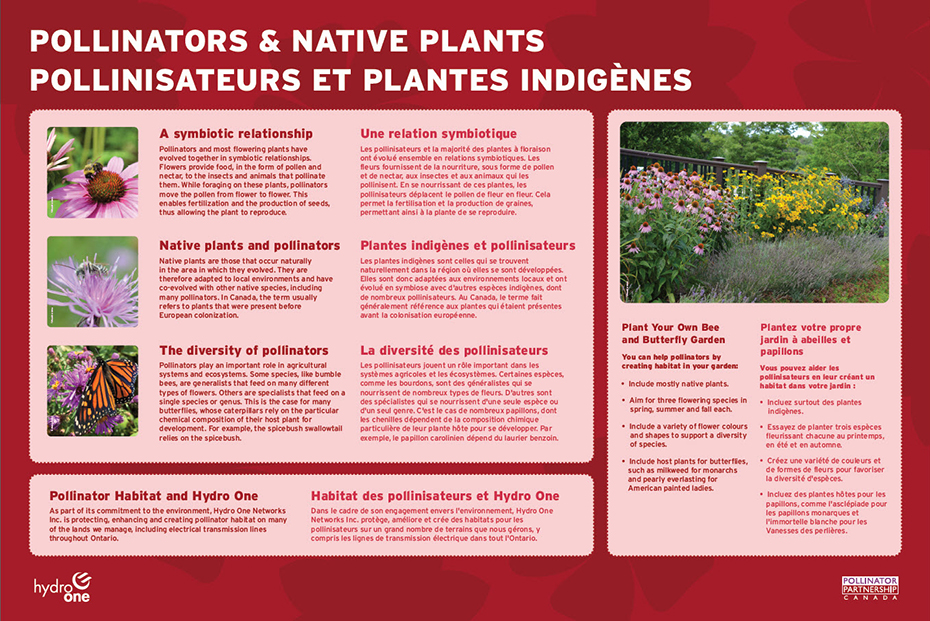Michael Farrell, an environmental planner and engineer at Hydro One, worked on the first pollinator habitat site near Orangeville, Ontario in 2015 and has been getting his hands dirty ever since.
“I go back every year to observe our first habitat site, take photos and document the progress,” Farrell says. “During my most recent visit, I was thrilled to see the habitat looking incredibly diverse. A pollinator site takes time to look good; often it will look like a bunch of weeds or grass to the casual observer, sometimes there are specific species of flowers present, and sometimes we’re entirely unsuccessful.” He adds that, on average, a successful and productive pollinator habitat takes 2-3+ years for full establishment. It is only then that the wide range of pollinator-friendly plants we introduce can be seen. Every site is a learning experience.

Since 2015, Farrell, along with landscape architect colleagues and the Hydro One forestry team, have created over 125 hectares of pollinator-friendly habitat across the province. Over the past year, they’ve planted 20 hectares of site-specific native pollinator mix, primarily in the Peterborough and London areas.
In 2021, Hydro One was awarded the Environmental Excellence award from the Electricity Distributors Association for its pollinator program success.
Contributing to Ontario’s biodiversity
Hydro One’s Pollinator Habitat Program was initially created to support provincial policy. Right of Way (ROW) conditions, following mechanical vegetation management activities, were identified as the perfect spot to add biodiversity value by creating pollinator sites. Pollinator-friendly species (flowering plants) grow best when they start from bare earth because of the need for seed-to-soil contact. Since its inception, the Pollinator Habitat Program has grown to include the establishment of pollinator habitats at Hydro One-owned station sites.

So what’s the buzz with pollinator habitats?
A common misconception is that pollinator habitats are only for bees. Insects and animals, such as butterflies, flies, beetles, ants, wasps and hummingbirds are other examples of imperative pollinators in Ontario. They play an important role in providing pollination services to plants and help them complete their lifecycles and contribute to the growth of fruits and vegetables that we all enjoy. Pollinators will search for a habitat to find food, mates and somewhere to nest, raise their young, rest and seek protection.

Farrell says finding a suitable pollinator habitat at a Hydro One station or ROW takes time and coordination with environmental experts. External partners are instrumental in identifying suitable, priority locations in the province to establish pollinator habitats. Planning and site preparation are critically important to a successful project. It can take up to a year before seeding takes place. The best time for planting is in the spring and fall and the rule of thumb is to focus on planting the right seed at the right place at the right time; always native and ideally locally sourced.
“Native plant species make a huge difference, in a collective way,” Farrell says. “They preserve Ontario’s biodiversity, they’re non-invasive, and grow within their natural range without putting other plant species at risk.”
Farrell and his colleagues have regular touchpoint meetings with partner associations like Canadian Wildlife Federation, ROW as Habitat working groups, Pollinator Partnership Canada, local Conservation Authorities (e.g. TRCA), and native seed producers. The purpose is to share knowledge and information and to stay abreast of everything from changing regulations and standards to seed requirements and land conditions.
This past summer, the New York Power Authority (NYPA) presented a workshop to Hydro One Forestry staff to showcase the amazing work they’re doing across the border.
“They’re doing things in a very different way and it was really interesting to learn more,” Farrell says. “It’s important to stay on top of best practices and learn from others to see how we can adjust our vegetation management practices and consider other options, like the more passive restoration approach shown by NYPA.”
Creating your own pollinator habitat
Designing a garden for pollinators doesn’t need to be extravagant or expensive. You can even start with a few potted flowers to attract bees and butterflies.

Organizations such as Pollinator Partnership Canada, the Canadian Wildlife Federation, and Carolinian Canada offer initiatives and resources for Ontarians looking for guidance on creating their own pollinator garden. Farrell says the majority of Ontarians are in areas under conversation authority and should connect directly with local organizations for assistance.
5 tips to get started:
- Choose a location: You don’t need to designate significant yard space to create an impactful pollinator habitat. If you live in a condo or apartment, a balcony will work. Use pots or raised flower beds.
- Use only native plants: If you’re not familiar with native plants, it’s important to do your research.
- Keep your plants healthy: Plants and flowers have different needs. Research your native plants to better understand what they need to thrive.
- Select a variety of plants: A variety of plants will invite pollinators all season long as things come in and out of bloom.
- Reach out to your local community: Many municipalities and neighborhoods have local groups interested in this topic to support you.